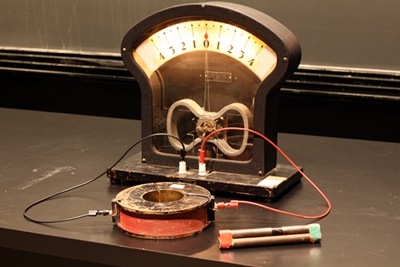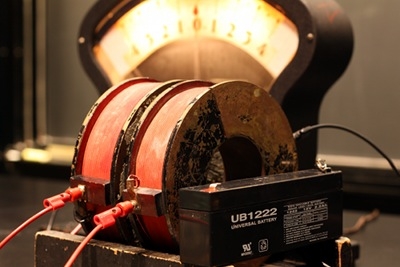A bar magnet or other source of magnetic field induces a current in a coil of wire when the magnetic flux through the coil changes.
 |
 |
What It Shows
An electric current in one conductor can induce a current in a separate conductor. The inducing current must change over time or space--or both--relative to the other conductor. For example, a surge of current in a stationary coil of wire can induce a current in a seperate stationary coil, or a coil with a steady current can induce a current in another coil if the two move relative to each other. These were some of the observations made by Michael Faraday as he worked to understand induction.1
Since an electric current gives rise to a magnetic field, the induction we observe must be an interaction between a conductor and a changing magnetic field.
When the flux of an external magnetic field through a closed surface changes over time, an electromotive force (emf) is induced around the perimeter of that surface. More practically, if the magnetic flux through the opening of a loop of wire changes with time, an induced emf will push electric current through the wire. A changing magnetic field gives rise to an electric field which, in turn, can push an electric current through a circuit; this is in contrast to Oersted's Experiment, where we see an electric current giving rise to a magnetic field.
How It Works
A coil of wire is connected to a Galvanometer or other current-sensing device. A cylindrical permanent magnet of sufficient strength is pointed at the center of the coil. As the magnet is moved closer or further away from the coil, a current--whose magnitude and direction depends on the speed and polar orientation of the moving magnet--is registered by the meter.
A similar coil connected to a battery can replace the permanent magnet. If we place both coils next to each other, we can observe the induced current as the battery is connected and disconnected. An iron bar through the center of both coils will enhance the interaction.
Comments
We commonly use one (or both) of our two 48.5 mH coils, roughly 10 cm diameter and wound with cloth-covered wire (internal resistance is about 4 Ohms). They can connect easily to one of our two large Cenco Scientific Galvanometers (internal resistance about 300 Ohms), which have large displays that can be easily read from the audience. Please take care when handling the Galvanometers, and make sure the inputs are shorted-out before moving them. The coils can rest flat on the lecture bench or be propped up with wooden blocks. A 12V gel cell battery works well.
1 Purcell, Edward M "Electricity and Magnetism" 2nd Ed pp 257-8